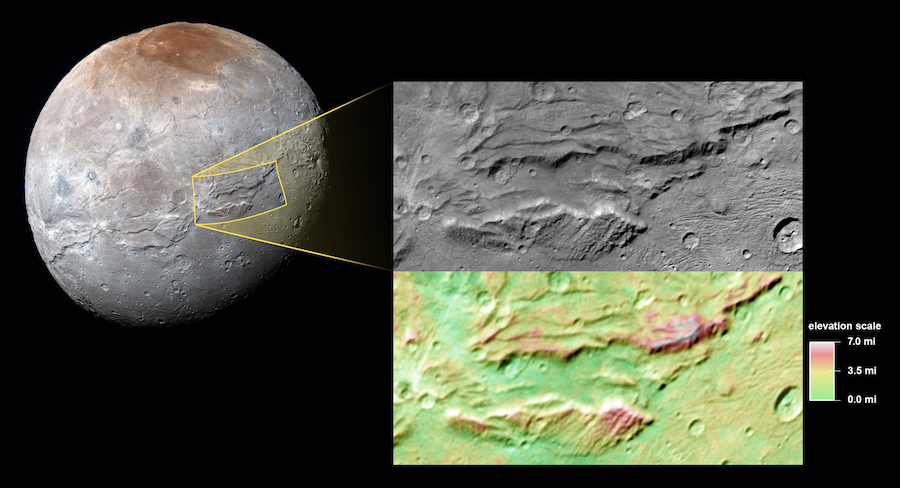
One of the most surprising discoveries in recent years in the outer Solar System is that there are small moons which have oceans inside them. Jupiter’s moon Europa and Saturn’s moon Enceladus are now known to have global oceans of water beneath their icy crusts, and others are thought to as well, including Ganymede, Titan, and possibly others. These moons have a lot of ice and rock as well, and gravitational tugging and heating from the large gas giant planets helps maintain a deep layer of liquid water inside them, where otherwise they would most likely be frozen solid in the deep cold so far from the Sun. Now it seems that another moon also once had an ocean, although in this case it is thought to now be solid ice: Pluto’s largest moon, Charon.
The findings suggest that there used to be an ocean below Charon’s surface, but it has long since frozen, with the expanding ice causing the surface to stretch and fracture. Evidence of this can be seen all over the moon in images taken by the New Horizons spacecraft during its flyby of Pluto last summer. Ridges, scarps, and valleys reveal a history of tectonic activity on this small world; in some places, the valleys can be 4 miles (6.5 kilometers) deep. It is a surprising amount of geological activity for such a tiny and cold body in the outer fringes of the Solar System, in the Kuiper Belt.
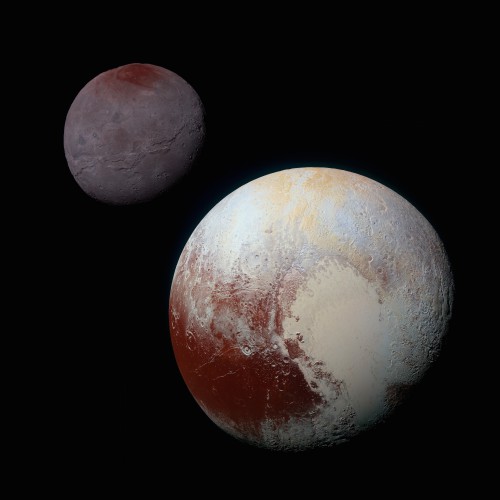
Radioactive decay of elements as well as some internal heat left over from the moon’s formation would have helped to keep a layer of liquid water beneath the surface, but eventually it would have cooled down with little or no other sources of heat available. Pluto and Charon are mutually tidally locked, orbiting a common center of mass (barycenter) as a “binary planet,” so gravitational tidal heating is unlikely or at least would operate differently than with an icy moon orbiting a gas giant planet. Since water expands when it freezes, it kept pushing outward until Charon was almost “bursting at the seams.” This led to fracturing of the surface that dwarfed even the Grand Canyon on Earth. Serenity Chasma, part of a vast equatorial belt of chasms on Charon, is at least 1,100 miles (1,800 kilometers) long, with chasms 4.5 miles (7.5 kilometers) deep. The Grand Canyon is only 277 miles (446 kilometers) long and just over a mile (1.6 kilometers) deep, by comparison. That is incredible geological activity for a body much smaller than Earth. Also, Charon’s ocean may be frozen now, but youthful-looking regions on the surface suggest that geological activity there continued for a long time, and perhaps even still does.
As posted earlier on AmericaSpace, there was also a previous study, from before the flyby, which suggested Charon once had a liquid subsurface ocean.
“The New Horizons spacecraft should provide the first images of the surfaces of Pluto and Charon,” according to the researchers, which was published on the journal Icarus. “Our predictions indicate that the presence (or absence) of tidally driven fractures could be used to constrain Charon’s internal structure and orbital parameters at the time of fracture formation. Furthermore, these fractures should be distinct from those produced through orbital recession and de-spinning. If tidally driven fractures are quite prevalent, it would require that Charon experienced a high eccentricity during its orbital evolution and that the ice shell remained relatively warm during this time period. In contrast, very limited tidal fracturing would place upper limits on Charon’s eccentricity and the viscosity of the ice shell. The specific distribution of fractures, either sparse or numerous, could be used to further distinguish between a thick and thin ice shell.”
As Dr. Alyssa Rhoden, a planetary scientist at NASA’s Goddard Space Flight Center, noted:
“Our model predicts different fracture patterns on the surface of Charon depending on the thickness of its surface ice, the structure of the moon’s interior and how easily it deforms, and how its orbit evolved. By comparing the actual New Horizons observations of Charon to the various predictions, we can see what fits best and discover if Charon could have had a subsurface ocean in its past, driven by high eccentricity.”
Another interesting feature on Charon is the “mountain in a moat,” an unusual depression in the surface, with a large mountainous block sitting inside it. Geologists aren’t yet sure how this feature formed, but it does provide more evidence for Charon being a more geologically active place than first thought.
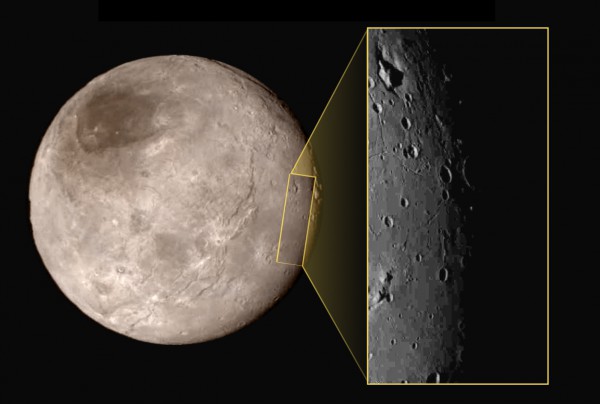
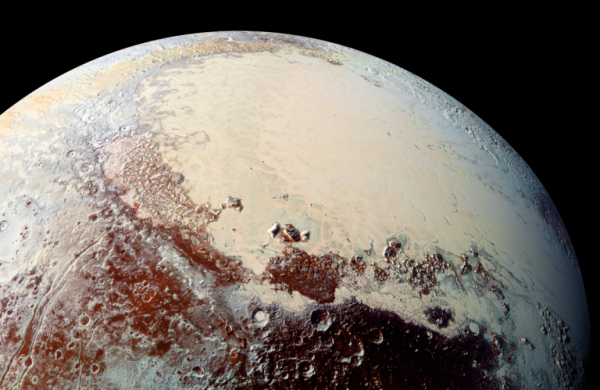
“The most intriguing feature is a large mountain sitting in a moat,” said Jeff Moore with NASA’s Ames Research Center, Moffett Field, Calif., who leads New Horizons’ Geology, Geophysics and Imaging team. “This is a feature that has geologists stunned and stumped.”
As also recently reported, Pluto itself has seas of sorts on its surface, notably the Sputnik Planum region, but they are frozen nitrogen, not water ice. There are, however, “icebergs” of water ice which “float” in this frozen sea. At Pluto’s extremely cold temperatures, the nitrogen ice flows very slowly in the same manner as glaciers on Earth. The “coastline” mountains are also composed of water ice, which on Pluto is as hard as rock. It is another example of processes which can mimic those on Earth, but in some cases, involve completely different materials. The frozen nitrogen is thought to gradually rise up to the surface from below, sort of like what happens in a lava lamp. This creates a surface marked by distinct “convection cells” divided by troughs. In places, the surface is also covered in many small pits, also thought to be linked to the convection process.
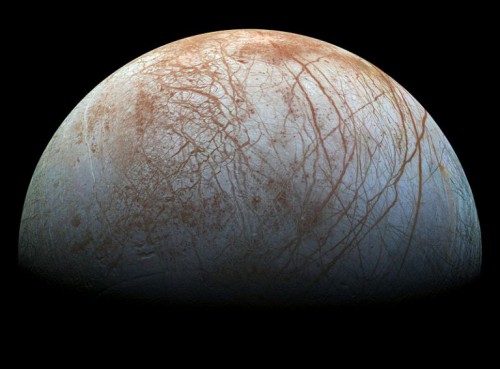
Pluto also has a surface with tectonic features, like Charon, as well as impacts, mass wasting, and possible cryovolcanism (ice volcanoes). From a recent paper:
“The New Horizons encounter revealed that Pluto displays a surprisingly wide variety of geological landforms, including those resulting from glaciological and surface-atmosphere interactions as well as impact, tectonic, possible cryovolcanic, and mass-wasting processes. This suggests that other small planets of the Kuiper Belt, such as Eris, Makemake, and Haumea, could express similarly complex histories that rival those of terrestrial planets. Pluto’s diverse surface geology and long-term activity also raise fundamental questions about how it has remained active many billions of years after its formation.”
There is also now a new geological map of Pluto, showing Sputnik Planum and surrounding terrain, covering 1,290 miles (2,070 kilometers) from top to bottom. All of the terrain has been imaged at a resolution of approximately 1,050 feet (320 meters) per pixel or better. It illustrates how Pluto has been more geologically active than many scientists had anticipated, along with Charon. But not just in the past—a complete lack of craters in regions such as the Sputnik Planum ice sea and flowing glaciers indicate that Pluto is still geologically active even today.
Charon’s ocean may now be frozen, but even just the fact that it used to have liquid water below the surface is a fascinating discovery. Whether there was any time, or the right conditions, for any sort of life to develop is completely unknown at this point, but the finding, along with moon such as Europa and Enceladus, suggest that there may be many such “water worlds” out there. If they are relatively common in our own Solar System, what about all of the other exoplanets and solar systems in the universe? Exoplanets are now being found by the thousands, with billions estimated in our Galaxy alone. What about all those other moons which are likely just as common?
The findings at Charon and Pluto also provide important clues as to what else may be waiting to be discovered on (or in) other objects in the Kuiper Belt. As so often seems to be the case, our Solar System is full of surprises.
Follow our New Horizons mission page for regular updates.
Be sure to “Like” AmericaSpace on Facebook and follow us on Twitter: @AmericaSpace
Missions » New Horizons »




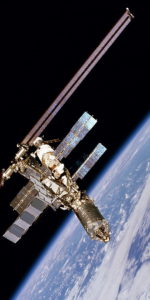
One Comment
One Ping
Pingback:Pluto Revealed: Five New Science Papers Highlight Discoveries by New Horizons « AmericaSpace